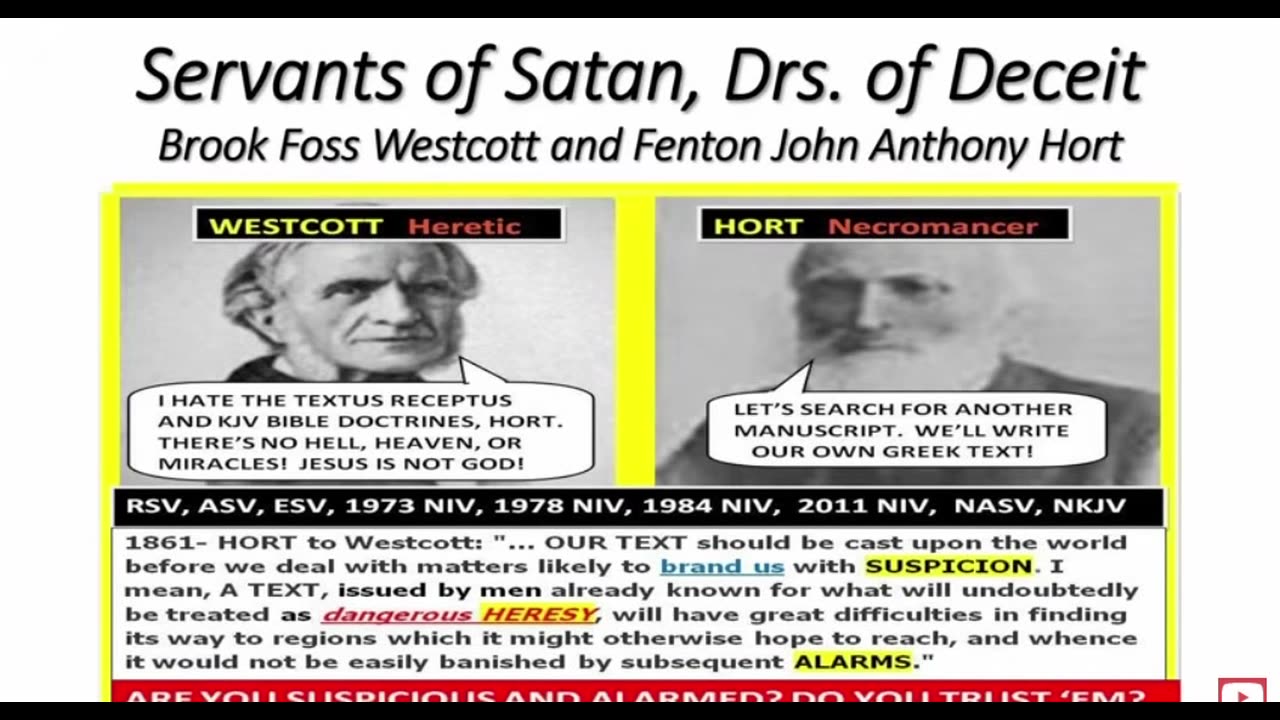Premium Only Content

The Great Bible Deceptions
1. That in the title of Chapter VI, the author begs the question by assuming that whenever the same or similar reading occurs in ARV as is found in Douay, therefore ARV obtained it from Douay; in other words, that a Douay reading? in ARV by design, and this in spite of the fact that no Catholic sat on the Revision Committee, and that ARV is a revision of the AV by a large body of Protestant scholars in the light of the best Greek MSS, not in the light of Douay. RABV 111.5 2. That in his opening remarks in Chapter VI, the author allows no correction, improvement, or revision of the Greek text in the light of the older, more complete, and better attested MSS, and many more in number, that have come to light and been critically studied by a large number of expert scholars since the one man Erasmus made up his hasty text from a few MSS under pressure of competition with another printer than his employer, but which the author calls “a pure Greek text.” RABV 111.6 3. That because a considerable number of individually translated versions “all in the main agree with the change of thought in the Revised,” both these and the Revised “were the products of a common influence.” The influence plainly meant by the author is one outside the Bible and the MSS, namely, the Jesuit Influence; whereas, one would logically conclude that the influence bringing so uniform a result from scholars widely scattered and working individually, was that of a text so well perfected by devout scholars in the work of generations that little room for essential divergence was found by the translator. It surely does not make our Bible Catholic to say the same thing a Catholic version says if the Catholic version says the same thing the best attested MSS say. RABV 112.1 4. That summing up the examination of all the texts brought forward by the author to prove the laterad contention of the entire book, namely, that the product of the Revisers is a manipulated, mutilated, corrupted, Romanized, modernized, unreliable version of the Holy Scriptures, and that the changes in reading seriously affect fundamental doctrines of the gospel as we understand and teach them, and constitute “blow after blow against the truth” and “blow after blow in favor of Rome,” we find the following results: RABV 113.1 Out of 17 Scripture passages reviewed in Chapter VI to show that “the Jesuit Bible reappears in the ARV,” only 9 in the most liberal allowance can be said to touch doctrine at all. Out of these 9 passages, 8 do not mis-state any doctrine, and wherein they can be made to appear by omission of a word or phrase to stop short of expressing some added detail of doctrine, that same detail is expressed numerous times in other scriptures of the same version. In the one remaining instance of the 9, the author mis-states the doctrine on the time of the judgment when he criticises the change from the rendering of the AV where the latter mis-states it. See page 97. RABV 113.2 In every one of the remaining 8 of the 17 passages examined, the point omitted in 4 instances is fully expressed or made clear in parallel passages, in 2 instances in the context, and in 2 instances in the margin, and in some instance in two or all three of these ways,—all in the same version. RABV 113.3 5. That in the opening remarks of the author in Chapter XI, he allows no motive for placing alternative readings in the margin except “to sow, broadcast, doubts about the sacred utterances,” whereas seven of the very passages he brings forth for examination give in the margin the exact reading of the AV. If these AV readings “cast doubt on the sacred utterances” it is a pity they are found in its own text, and a good thing they have only a secondary place in the margin of ARV. In five other passages cited, the marginal reading simply gives the literal rendering of a textual reading exactly like the AV. RABV 113.4 6. That, again, the author allows no motive to the painstaking care to be exact that is obvious in his quotation from the Chairman of the English Revision Committee, but a “settled purpose... that doctrine should be changed,”—and of course in harmony with the Chairman’s theological views! Had not such painstaking care been taken to be true to the original, we should still have some of the obvious errors in AV to deal with. RABV 114.1 7. That summing up the examination of all the 31 scriptures brought forward by the author in Chapter XI to illustrate “blow after blow against the truth,” we find the following results: RABV 114.2 (a) Only one blow that can really be said to be “against the truth,” and that one not contrary to truth but stating only part of the truth, namely, the rendering of 2 Timothy 3:l6, “Every scripture inspired of God is also profitable” rather than “all scripture is inspired of God and is profitable,” the meaning turning on where the is, not expressed in the original, is placed. The latter rendering by AV is given in the margin as an alternative reading. RABV 114.3 (b) Three of the blows cited are positively blows for the truth, namely, the more accurate rendering of John 5:39; Acts 3:19; 2 Timothy 4:l, thus correcting obvious errors in AV, involving no change whatever in the Greek text except the single instance in Timothy of substituting the better attested kai, and, for kata, at, thus relieving the text of an error on the time of the judgment. RABV 114.4 (c) Eight of the blows involve only change from a more fr RABV 114.5
-
 2:16:21
2:16:21
Side Scrollers Podcast
18 hours agoTwitch has a SERIOUS Problem + Leaflit’s VIRAL Interview + More | Side Scrollers
42.6K13 -
 21:55
21:55
GritsGG
14 hours agoMega Win Streak On Warzone! Over 4100 Wins on BO6 WZ!
4.83K1 -
 20:22
20:22
The Pascal Show
1 day ago $3.00 earnedARE THEY IGNORING HER?! Is The White House & FBI Ignoring Candace Owens' A**assination Claims?!
29.2K16 -
 1:00:45
1:00:45
TruthStream with Joe and Scott
1 day agoMondays with Matt Geiger from Verity Metals: Gold, Silver, The Housing Market and more. Live 12/1 6pm pacific #519
9.6K -
 2:17:46
2:17:46
The Connect: With Johnny Mitchell
3 days ago $14.79 earnedA Sitdown With The Real Walter White: How An Honest Citizen Became A Synthetic Drug Kingpin
81K2 -
 2:40:08
2:40:08
PandaSub2000
11 hours agoDEATH BET | Solo Episode 01 (Edited Replay)
6.54K1 -
 LIVE
LIVE
Lofi Girl
3 years agolofi hip hop radio 📚 - beats to relax/study to
555 watching -
 2:03:38
2:03:38
Inverted World Live
9 hours agoSatanic Pedophile Network in Australia | Ep. 149
235K56 -
 3:34:45
3:34:45
TimcastIRL
9 hours agoCandace Owens Implies TPUSA KILLED Charlie Kirk, Claims Failed Bibi Deal Cost MILLIONS | Timcast IRL
232K174 -
 6:38:10
6:38:10
SpartakusLIVE
10 hours agoTrios w/ The BOYS on WZ and then we're teaching Jean ARC RAIDERS
86.6K7